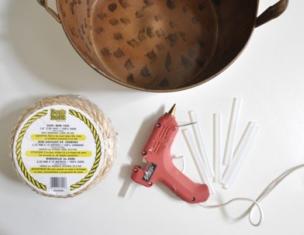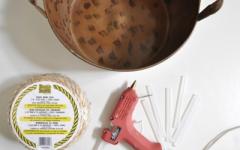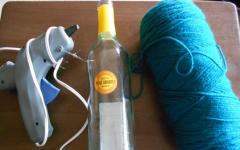/ 23.04.2016 at 22:33
Greetings you, dear friends!
It is unlikely that there is a needlewoman who would not want to decorate their home with original and exclusive products made by their own hands. After all, such a thing will not be able to replace any other, bought in the store, even if you are the most beautiful!
I decided to devote this article to the knitted blanket. Tie the plaid - the case, of course, time consuming. But if you ask the goal, and do a little, then everything is not so scary.
let's consider a variety of ideasHow to knit plaid. The most profitable, in my opinion, is the way to do it from squares or strips, and not knit a solid canvas with the needles.
With this method, some small details fit, and then they are collected in a single whole.
And it is easier to knit "spare parts", you can grame once and anywhere. Agree that you can always wear with you a small tangle with a small knitted detail, and with the slightest opportunity to tie.
Squares can be knitting the most diverse ways. different sizes. The main thing is to include your creative imagination And come up with how it all beautifully complicate. Or to watch ideas, how others do it. And the options are a lot! I spied, and now I will try to classify them some.
Here is a "family" plaid from squares related to the same principle. And they look everything in different ways, due to the fact that different colors and methods of the connection are used.
Such squares can be knit from both monophonic yarn and from the yarn of sectional dyeing. And you can use the remains of yarn for this purpose.


Little advice. When using residues of yarn for knitting squares, it will be better if new thread Attach at the beginning, or the end of the row, and not somewhere in his middle. It will be more convenient to hide the thread tips on the edges in the connecting seams, and the product will look more accurately.
How to knit squares from the corner
Knit squares from the corner is very simple. We recruit the odd number of loops. The number of loops depends on the square of which size you want to get. Well, and from the thickness of the yarn, the spokes and knitting density also. The sides of the square will be equal to half the length of the set row.
Suppose for example, we scored 33 loops. Preliminary calculation: From the number of loops scored, we subtract 3, and the obtained number is divided by 2. We get: (33 - 3): 2 \u003d 15. It is necessary to know where to start making a loot to know. And the second point: the side of the square will be like 15 loops in knitting handwriting.

- 1st row: all loops facial;
- 2nd row and all subsequent balls (in this case, they go on facial side Works): All loops are facial, but the average 3 loops of the row are shattered together by the front of the permutation, so that the average loop is on top (in detail about the ways of touching you can see ).
That is, from our preliminary calculation received the number 15. Consequently, before the accurate, which we do, tied 3 loops together, knit 15 loops (the edge included in this account), and after the accumulation they are inserted 15 loops. In follow-up rows, this number of loops will decrease by 1 loop on each side.
- 3rd row and all subsequent odd rows (In this case, these rows go on point side Works): All loops are facial, and the loop, which in the previous row received from the provisions of the 3-loops together, remove the wrong, leaving the thread ahead of the work. If you wish, you can not remove it, but to penetrate the wrong loop.
We continue to knit this way until 3 loops remain on the needle. Slip them together facial loop method broach. We tear the thread, in the last formed loop, we produce the tip of the thread and delay. Square is ready.
By the same principle, you can knit squares and other patterns, and 3 loops together to lie in another way. Here you can already pochatinate.
For example, in the photo below, the squares are associated not just a handwriting with the refusals in the middle, and the strips of the face alternate are mixed with rows from the wrong loops.

When the squares are ready, they are laid out on a flat surface to combine and understand which plaid you want to get in the picture and in size. And then the squares are connected.
Connection methods can also be different. You can just gently sew them knitted seam, but you can connect with crochet using columns without Nakid. Or come up with more complex and intricate connectivity options, both with the help of a hook and with the help of the spokes. As, for example, on these plaids:


Plaids from squares associated with different patterns.
This is a more complex way in the sense that you need to think very well, what patterns and from yarn what colors to knit so that it is harmoniously looked. But here such a flight for fantasy! And if the patterns of finding uncomplicated, then this method is suitable for beginners of knitters.

As you can see, the patterns are not very complicated, but everything is beautifully combined both in color, and in the drawing. You just need to first draw a common picture (technical figure) of your future blanket on paper, imagine how it will look, and then proceed to the confusion of individual squares different patterns.
If you wish, you can generally create a masterpiece if you connect different techniques – jacquard, aran knitting. See ourselves with what beautiful drawings are the plaids:


06.03.2015
Collection of simple patterns with embossed squares and cells
Relief patterns with knitting needles are an alternation when knitting facial and invalid loops, while the cloth is obtained three-dimensional due to the combination of convex and concave sites, as well as sufficiently dense (without lumen). Therefore, such patterns are especially expressive. Relief patterns There are a great set, they differ in small or large rapport. These patterns are ideal for smooth cotton yarn, cotton with viscose, silk and blended flax yarn. If the yarn is thick, the pattern looks especially relief, and if it is thin, then the exquisite, noble structure will be. Relief patterns are quite simple in knitting, so they are recommended for beginner masters, because Helps them to gain skills and experience. Confident knitters also do not bypass the relief patterns, because they are comfortable for combining with an openwork and give it a special kind. To charm relief patterns It did not disappear, you should not iron and process the ferry, it is enough to moisten and give to dry in the collected form.
We offer you large collection uncomplicated patterns S. relief squares and squares, cells and knitting cells with visual samples, schemes, descriptions and conventional symbols. Choose and create with pleasure!
Reduction:
p. - loop;
persons. - facial;
izn. - Announcement;
chrome. - edge;
screen. - crossed.
Attention! In the schemes, the invalid rows are given as they look from the front side.
※ Pattern 85 "Ladushka" (12 loops and 16 rows)

※ Pattern 84 "Spartak" (16 loops and 16 rows)

※ Pattern 83 "block masonry" (9 loops and 16 rows)

※ Pattern 82 "Surprise" (14 loops and 20 rows)

※ Pattern 81 "big lats" (8 loops and 20 rows)

※ Pattern 80 "Little Lats" (for 6 loops and 12 rows)

※ Pattern 79 "quadrices" (12 loops and 20 rows)

※ Pattern 78 "Snacks" (12 loops and 14 rows)

※ Pattern 77 "Cookies" (14 loops and 20 rows)

※ Pattern 76 "Squares with crossed loops" (18 loops and 28 rows)

※ Pattern 75 "Flower Motive" (18 loops and 24 rows)

※ Pattern 74 "Marble" (8 loops and 14 rows)

※ Pattern 73 "Miniature Squares" (for 6 loops and 14 rows)

※ Pattern 72 "Idylliya" (14 loops and 28 rows)

※ Pattern 71 "Quada-ticks" (on 13 loops and 20 rows)

※ Pattern 70 "Square Idea" (12 loops and 12 rows)

※ Pattern 69 "Princess" (20 loops and 40 rows)

※ Pattern 68 "Caprice-2" (14 loops and 28 rows)

※ Pattern 67 "Caprice-1" (14 loops and 28 rows)

※ Pattern 66 "buttons" (12 loops and 12 rows)

※ Pattern 65 "diagonal of squares" (12 loops and 24 rows)

※ Pattern 64 "Barrel" (for 6 loops and 8 rows)

※ Pattern 63 "Original Relief" (8 loops and 20 rows)

※ Pattern 62 "Sails" (for 7 loops and 12 rows)

※ Pattern 61 "Variation" (on 26 loops and 12 rows)


※ Pattern 60 "Squares of triangles" (9 loops and 10 rows)

※ Pattern 59 "Domino" (7 loops and 12 rows)

※ Pattern 58 "hypotenuse" (10 loops and 14 rows)

※ Pattern 57 "Domino-Square" (for 19 loops and 19 rows)

Dial 21 p. (\u003d 19 p. + 2 chr.)
1 row: 9 persons. behind the front wall; 1 persons. for the back wall; 9 persons. For the front wall.
2 rows: 9 persons. behind the front wall; 1 is elected; 9 persons. For the front wall.
3 rows: 8 persons. behind the front wall; 3 p. Together persons. for the back wall (medium loop from above); 8 persons. For the front wall.
4 rows: 8 persons. behind the front wall; 1 is elected; 8 persons. For the front wall.
5 rows: 7 persons. behind the front wall; 3 p. Together persons. for the back wall (medium loop from above); 7 persons. For the front wall.
6 rows: 7 persons. behind the front wall; 1 is elected; 7 persons. For the front wall.
7 rows: 6 persons. behind the front wall; 3 p. Together persons. for the back wall (medium loop from above); 6 persons. For the front wall.
8 rows: 6 persons. behind the front wall; 1 is elected; 6 persons. For the front wall.
9 rows: 5 persons. behind the front wall; 3 p. Together persons. for the back wall (medium loop from above); 5 persons. For the front wall.
10 rows: 5 persons. behind the front wall; 1 is elected; 5 persons. For the front wall.
11 rows: 4 persons. behind the front wall; 3 p. Together persons. for the back wall (medium loop from above); 4 persons. For the front wall.
12 rows: 4 persons. behind the front wall; 1 is elected; 4 persons. For the front wall.
13 rows: 3 persons. behind the front wall; 3 p. Together persons. for the back wall (medium loop from above); 3 persons. For the front wall.
14 rows: 3 persons. behind the front wall; 1 is elected; 3 persons. For the front wall.
15 rows: 2 persons. behind the front wall; 3 p. Together persons. for the back wall (medium loop from above); 2 persons. For the front wall.
16 rows: 2 persons. behind the front wall; 1 is elected; 2 persons. For the front wall.
17 rows: 1 persons. behind the front wall; 3 p. Together persons. for the back wall (medium loop from above); 1 persons. For the front wall.
18 rows: 1 persons. behind the front wall; 1 is elected; 1 persons. For the front wall.
19 rows: 3 p. Together of persons. Behind the back wall (medium loop from above).
※ Pattern 56 "Squares and Bows" (9 loops and 10 rows)

※ Pattern 55 "Pearl blocks" (14 loops and 18 rows)

※ Pattern 54 "woven" (for 6 loops and 12 rows)

※ Pattern 53 "Aquarium" (14 loops and 16 rows)

※ Pattern 52 "Wink" (8 loops and 12 rows)

※ Pattern 51 "Beresta" (on 9 loops and 12 rows)

※ Pattern 50 "binding" (for 9 loops and 10 rows)

※ Pattern 49 "Tuesok" (16 loops and 32 rows)

※ Pattern 48 "Big basket" (16 loops and 16 rows)

※ Pattern 47 "Small basket" (10 loops and 8 rows)

※ Pattern 46 "Big Body" (on 8 loops and 8 rows)

※ Pattern 45 "Small Bodybubles" (for 6 loops and 8 rows)

※ Pattern 44 "braided relief" (for 6 loops and 12 rows)

※ Pattern 43 "braid" (for 6 loops and 8 rows)

※ Pattern 42 "Two-color braid" (for 6 loops and 8 rows)

※ Pattern 41 "Lukoshko" (8 loops and 12 rows)

※ Pattern 40 "Candelabra" (20 loops and 20 rows)

※ Pattern 39 "Shapito" (18 loops and 18 rows)

※ Pattern 38 "Wafers" (for 6 loops and 6 rows)

※ Pattern 37 "Kalinka-Malinka" (for 6 loops and 6 rows)

※ Pattern 36 "Rensit Squares" (14 loops and 16 rows)

※ Pattern 35 "horseshoes" (14 loops and 24 rows)

※ Pattern 34 "Irisky" (10 loops and 10 rows)

※ Pattern 33 "Mill" (on 20 loops and 36 rows)

※ Pattern 32 "Windmill" (14 loops and 12 rows)

※ Pattern 31 "Small pockets" (12 loops and 16 rows)

※ Pattern 30 "pockets" (17 loops and 20 rows)

※ Pattern 29 "Original Chess" (16 loops and 24 rows)

※ Pattern 28 "Chess Field" (16 loops and 16 rows)

※ Pattern 27 "Chess 5x5" (10 loops and 14 rows)

※ Pattern 26 "Chess 4x4" (8 loops and 8 rows)

※ Pattern 25 "Chess 3x3" (for 6 loops and 8 rows)

※ Pattern 24 "Muckers" (15 loops and 30 rows) the reverse side of the "Yin-Yan" pattern

※ Pattern 23 "Yin-Yan" (15 loops and 30 rows) the reverse side of the "bucket" pattern

※ Pattern 22 "Sea Battle" (14 loops and 20 rows)

※ Pattern 21 "expression-2" (12 loops and 12 rows)

※ Pattern 20 "Expression-1" (12 loops and 12 rows)

Hello, guests are expensive!
I do not know whether you are interested openwork patterns Spokes with schemes in the middle of winter. Just we have a sun shine, warmly re-made, spring wanted - so I pulled me on the openwork Tuzhoore.
Although these openwork patterns are not very complicated, some of them I decided to accompany not only schemes, but also by the description. It will help you better figure out how to knit such interesting and beautiful patterns spokes.
Very often in knitting books, and on the Internet, knitting patterns are published without names, and this is not entirely convenient when searching for a particular pattern. I took the courage to give them name in my blog. Are you not against?
Openwork patterns with spokes
Pattern knitting "Openwork Copy"
I called this pattern "Openwork Copyright". Does he not reminiscent of corn pillars? In my opinion, it looks like.

To connect the pattern of the pattern, the number of loops divided by 8 add 6 loops for the symmetry of the pattern and 2 edges, for example 24 + 6 + 2 \u003d 32, and proceed to knitting the sample according to the scheme or description (as well as convenient).
Just be afraid, please, such a huge pattern of the pattern - many facial and invalible rows are repeated in it.
Pattern scheme "Openwork patch"

- a plus - edge loop;
- minus - announced loop;
- black Square - facial loop;
- circle - Nakid;
- the black ;
- 2 loops are tied together with the involving.
Description of the pattern
- In the 1st, 3rd, 5th, 7th, 9th rows knit: 1 Pouring, * 4 Pouring, 2 facial, Nakda, 2, together with a slope to the left, as described above * (from * to * We repeat to the end of the row), at the end of the row of 5 irons;
- in the 2nd, 4th, 6th, 8th, 10th rows: 5 facial, * 2 insoluble, nakid, 2 together with an invented, 4 facial *, at the end of the row 1 facial;
- in the 11th, 13th, 15th, 17th, 19th rows: 1 pouring, * 2 facial, nakid, 2 together with the slope to the left, 4 insoluble *, at the end of the row 2 facial, Nakda, 2 together with the inclination to the left, 1 purl;
- in the 12th, 14th, 16th, 18th, 20th rows: 1 facial 2 insoluble, nakda, 2 together with an invalible, * 4 facial, 2 insoluble, nakid, 2 in a combination *, at the end of the row 1 facial;
- we repeat the pattern from the 1st row.
Like most openwork patterns, "openwork pillage" perfectly suitable for knitting female and children's products.
Pattern knitting "arrows"
Pattern "Arrogo" Reminds pointers on the roads, do not find? Hence the name of the pattern.

To link the sample of this interesting pattern, we recruit the number of the loops of a multiple 14, add 1 loop for the symmetry of the pattern and 2 edges: 28 + 1 + 2 \u003d 31. Now go to knitting the sample by the pattern scheme.
Scheme of the "Arrogo" pattern

- a plus - edge loop;
- minus - announced loop;
- black Square - facial loop;
- triangle with a straight angle left -2 hinges are tied with a slope to the left (I remove the 1st loop as when knitting facial, the 2nd loop to the face and stretch through the removed loop);
- 2
- circle - Nakid;
- even ranks - knit, as the pattern shows, nakida - hinges.
Despite the fact that this openwork pattern, it can be used for knitting male jumper And pullovers.
Pattern knitting "Openworks"
Pattern "Openwork Squares" Perfect for knitting both female and children's clothing. I associated with this pattern.

To knit the pattern sample, we gain the number of loops dividing on 6, add 7 loops so that the pattern looks symmetrically, and 2 edge loops, for example: 24 + 7 + 2 \u003d 33 loops, and proceed to knitting the sample according to its scheme.
Pattern scheme "Openwork squares"

In the face rows, first knit 3 loops before the bracket (rapport), then 6 loops of the rapport, enclosed in the bracket repeat as many times as needed, and at the end of the row you knit the remaining after a bracket (rapport) 4 loops.
In the involving rows, knit, as the pattern shows (above the front-facial loops, over the involvene and hinges are invalid hinges).
Pattern knitting needles "lace leaf"
Agree, openwork pattern "Lace leaf" Declaring any female product.

In order to associate its sample, gain the number of loops, divided by 8, add 9 loops so that the pattern looks symmetrically, and 2 more edge loops: 16 + 9 + 2 \u003d 27. Well, the pattern of the pattern is at your service.
Pattern scheme "Lace leaf"

- a plus - edge loop;
- minus - announced loop;
- black Square - facial loop;
- triangle with a straight angle left - 2 loops are tied with a slope to the left
- triangle with direct angle to the right - 2 the loops are lying together face;
- circle - Nakid;
- white Arch - 3 Loops will spew together with the slope to the left (2 loops remove together as when knitting the facial, 3rd loop knit face and stretch it through 2 loop removed);
- even ranks - knit as the pattern shows, Nakida - involved.
Pattern knitting "Columns"
Your name in the knitting needles "Kolkovka" received in the competition "Give the name of the pattern!",which I arranged in my previous blog on knitting needles.
What are the suggestions not to give name pattern: and "flashlights" and air balloons", And" poppy boutons "... But I stopped at the" Kolinskok ", on the" bottom "of which even liquid is visible!

To connect the pattern of the pattern with the knitting needles, you need to dial the number of loops, divided by 6, add 1 loop for symmetry and 2 loops edge, for example: 30 + 1 + 2 \u003d 33 loops. Well, then you should knit according to the pattern scheme.
Pattern scheme "Columns"
- plus - edge loop;
- minus - the wrong loop;
- black Square - facial loop;
- triangle with a straight angle left - 2 hinges are tied with a slope to the left (I remove the 1st loop as when knitting the facial, the 2nd loop to the face and stretch through the removed loop);
- triangle with direct angle to the right - 2 The loops are lying together face;
- circle - Nakid;
- even rows - knitted as the pattern shows, nakida - involnenial loops.
Since the openwork "holes" in the pattern is very small, he will be perfectly looking not only for children and women's clothingbut on knitted products for men.
Pattern spokes of "fish tails"
I called this pattern "Fish tails"True, it seems? Knit it, of course, not as fast as previous patterns - more attention is required here, but the result is worth it!

To tie a pattern of the pattern "Fish tails", We recruit the number of loops, multiple 14, add 15 loops for symmetry of the pattern and 2 edge loops (14 + 15 + 2 \u003d 31). And then knit according to the pattern scheme.
Scheme of the pattern of "fish tails"

- plus - edge loop;
- minus - the wrong loop;
- black Square - facial loop;
- circle - Nakid;
- white triangle with direct angle to the right - 2 loops are in line with the involving;
- white triangle - 3 loops are tied together with the wrong one;
- even rows - knit as the pattern shows, nakida - involved.
You can use this pattern for both women's and children's knitted clothes.
Here are openwork patterns with spokes with schemes I prepared for you today's winter day. I hope they liked them and the patterns of the patterns were understandable. But even if it is not like that - write, I will definitely help figure out!
If these openwork patterns are complicated for some of you, you can go through the link to the page with more simple, but from it.
Well, if you do not want to accidentally skip any useful information for yourself, subscribe to receive new articles of my blog. Just do not forget to go to your email and confirm the subscription by clicking on the link in the letter that came automatically, otherwise the subscription will not be framed!
And this is a musical gift: "Echo of Love" performed by all the beloved Anna Herman. Listen and enjoy!
A huge number of things knitted spokes It may consist of separate small elements that combined with each other create very interesting canvases. Subsequently, beautiful plaids, bags and other things are obtained. Of course, parts can be of different geometric shapes, but now we will talk about knitting with the squares with the spokes, which in turn also can also differ significantly from each other. The surface is smooth or covered with contour pattern and even convex elements. This is a huge space for lovers to dream. Therefore, we will examine several options for squares: smooth, grandmother and diagonals.
Reduction:
- Row - R.
- Petit - P.
- Facial - LP.
- Announced -IP.
- Thread - N.
- Front wall loop - PS.
- Rear wall looping.
- Nakid - n / k.
The easiest way to knit squares is ordinary facial glady. They can be made of different colors or in two shades. Just type P, for example -48 and knit before the formation of the desired equilateral figure (approximately 66 rows):
 If the smooth canvas seems to be boring, then you can add a simple pattern of a simple pattern as in the diagram (alternating H / K (circle) and 2x П together (triangle), empty cells - LP):
If the smooth canvas seems to be boring, then you can add a simple pattern of a simple pattern as in the diagram (alternating H / K (circle) and 2x П together (triangle), empty cells - LP):
 You can still use the "chess" (rubber band 4x4, to change each other 4 p) or any other motif of the appropriate form.
You can still use the "chess" (rubber band 4x4, to change each other 4 p) or any other motif of the appropriate form.
Such a work will be asset even an inexperienced knitter. And the result will be a big and beautiful thing.
Video: Simple square tissue
Knitting Square with Diagonal
To make such a square, we recruit 25 P. Number P should always be odd. We will work only by LP. Now we need to tie the preparatory P in which some LP:
 2 p: 12 LP, move 1 n without tissue, as an IP (working H front), 12 LP.
2 p: 12 LP, move 1 n without tissue, as an IP (working H front), 12 LP.
Important: In the even p located in the middle of the ply, not tolding as an IP.
3 p: 11 LP, the following 3 P needs to be kept together. For this, 12 and 13 P are out of the PS on the right spin, and then again to the left and adding 14-yd to them, to prick their LP for the ZS.
IMPORTANT: In odd p, there are together 3 p according to the above described. As a result, one of the diagonals of the square will have the type of pigtails, and the amount of P gradually decrease. Knitting continue until 1 p, which is just tightened. Square is ready.
Video: Technique Patchwork Spokes
Square with two diagonals
We recruit the circular spokes of 8 P and closer to work in the circle. We use markers to mark 1,3,5 and 7 p .:
 1 p: \u200b\u200bIP. Performing knitting, add P at the beginning, at the end and between P. dialed should turn out to be 16 P.
1 p: \u200b\u200bIP. Performing knitting, add P at the beginning, at the end and between P. dialed should turn out to be 16 P.
2 P: We produce loops to and after each P, marker marked.
Alternate 1 p and 2 p, finish the square when it reached desired size On 2 R. Close as IP. The remaining H tighten the hole between the completed loops, and the segment H, which remained at the beginning of work, tighten the hole in the center of the square.
Try to knit freely, then your items will turn out to be smooth and flat. If the loops are tightened too much, it will lead to the distortion of the pattern.
Babushkin Square knitting option
This option consists, as a rule, from several colors, following each other in the form of strips. It is often used when creating some kind of children's things that are especially bright and interesting:
 To knit grandmotherkin square, type 20 P and knit 28 p using a knitting of a dark type with one tint:
To knit grandmotherkin square, type 20 P and knit 28 p using a knitting of a dark type with one tint:
 Must get a square. In 29 p, we close everything. In addition to 1. Deploy knitting and on one side of the figure of the figure gained new p already different color to the end of R. knit until it does not reach the desired effect. For example, 18 R. in 19 p again we make the closure of P, leaving one. Turn the grandmother's square further and start the set already on the other side, repeating the above described. So until we bind the first figure from all sides of the thread of another shade. Now we attach the third color and repeat:
Must get a square. In 29 p, we close everything. In addition to 1. Deploy knitting and on one side of the figure of the figure gained new p already different color to the end of R. knit until it does not reach the desired effect. For example, 18 R. in 19 p again we make the closure of P, leaving one. Turn the grandmother's square further and start the set already on the other side, repeating the above described. So until we bind the first figure from all sides of the thread of another shade. Now we attach the third color and repeat:
 Knitting can be performed by a stroke of a facial type or some pattern, for example, pearl. It is not necessary to place the colors exactly as:
Knitting can be performed by a stroke of a facial type or some pattern, for example, pearl. It is not necessary to place the colors exactly as:
 Each of the strips can be performed different shadesWhat will add a fig back to the figure. So here we plunge fantasy. Using grandmother's square, you can make interesting plaids or bags.
Each of the strips can be performed different shadesWhat will add a fig back to the figure. So here we plunge fantasy. Using grandmother's square, you can make interesting plaids or bags.
As you can see, there are many knitting ways to a lot of squares, but they all give an interesting and unique result, and most importantly not completely complex in performance. After completing all the number of shapes necessary for one or another product, spread all the items in the order you like and start to connect. Usually collect individual strips, which are already combined with each other.
Video: Overview of the square from squares
Schemes of square patterns










Bright volumetric Flower framed by emerald leaf listened. Knitted flower It looks colorfully and elegant, it will look good as a brooches, decorations for a hat, bags or blouses.
To knit a flower, you will need: the remains of yarn x / b red for a flower and emerald for the leaves, hook number 2.5.
Description of knitting flower:
Type a chain of 7 £ 7. loops, close it in the ring of the connecting loop and knit first rowBy making 3 remuneration. Loop loops, 15 tbsp. s / n.

In the second row To start the petals, we encounter 8 arches from 3 loops, knit * Art. B / N between the columns of the previous series, 3 remuneration. loops, st. B / N after 2 columns of the previous row, repeat from * 8 times. Finish the second row of connecting loop in the first century b / n and knit 3rd row Petals, tied from the army of Art. B / N, 3 tbsp. s / n, st. b / n. Finish the 3rd row of connective loop.

In the fourth row Knit arches from 4 posses. Povel for the next row of petals. Fix the arches by columns without an insertion, introducing a hook for the base of the previous army.

Fifth row: Release the second row of petals tied from the arches - Art. B / N, semi-solitary, 4 tbsp. s / n, semi-solitary, st. b / n.

Sixth row: Knit arches out of 5 rewards. Loops for the next row of petals, consolidate Art. B / n also for the base of the previous army.

Seventh row: Release the petals - art. b / n, semi-solitary, 6 tbsp. s / n, semi-solitary, art. b / n.

Having finished the 7th row, cut off, secure the thread and begin to knit the green thread of the leaves. For leaves at the beginning, also knit arches from 8 rewards. Peltlek, fixing them for the founding of the previous army. Hacking 9th row arches, in the 10th row Slide the leaves, tie from the arches: Art. b / n, semi-solitary, 2 tbsp. C / N, 5 tbsp. C / 2N, "Pico", 5 tbsp. C / 2N, 2 tbsp. s / n, semi-solitary, st. b / n.










